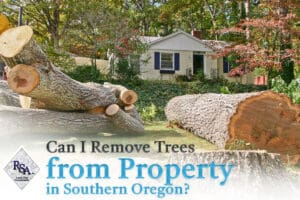 Owning rural property in Southern Oregon offers landowners a unique opportunity to enjoy nature, utilize natural resources, and even engage in timber harvesting or land development. Also, as wildfire risks grow, property owners are more interested in removing or logging trees from their land. However, tree removal and logging activities are subject to various laws and regulations depending on the zoning of the land, environmental protections, and local county requirements. Understanding these regulations is crucial for property owners to ensure compliance and avoid legal issues. We’ve compiled the following information to help you understand if you can remove trees from your property in Southern Oregon.
Owning rural property in Southern Oregon offers landowners a unique opportunity to enjoy nature, utilize natural resources, and even engage in timber harvesting or land development. Also, as wildfire risks grow, property owners are more interested in removing or logging trees from their land. However, tree removal and logging activities are subject to various laws and regulations depending on the zoning of the land, environmental protections, and local county requirements. Understanding these regulations is crucial for property owners to ensure compliance and avoid legal issues. We’ve compiled the following information to help you understand if you can remove trees from your property in Southern Oregon.
State-Level Regulations for Removing Trees from Property
The Oregon Department of Forestry (ODF) regulates tree removal on forested lands. If your property is designated as forestland, the Oregon Forest Practices Act (FPA) requires landowners to notify the ODF before conducting any commercial timber harvesting. These regulations promote sustainable forest management and prevent environmental degradation.
For example, if a landowner intends to harvest timber for sale, they must submit a notification to the ODF outlining the project’s scope. Depending on the scale of logging, additional requirements such as reforestation plans, stream buffer zones, and soil erosion control measures may be required. Even smaller-scale tree removal projects on forested properties may necessitate permits to ensure that logging activities do not disrupt natural ecosystems or increase wildfire risks.
Zoning and Local Ordinances Impacting Tree Removal
Local zoning laws significantly impact the ability to remove trees on rural property. Southern Oregon counties such as Jackson, Josephine, and Klamath have distinct regulations that vary depending on zoning designations, including:
- Forest Use (F) Zones: Land designated for forestry is typically subject to stricter regulations regarding tree removal and logging activities. Many forest-zoned properties require permits for logging, and landowners may need to comply with state forestry requirements, including the maintenance of firebreaks and conservation of protected tree species.
- Exclusive Farm Use (EFU) Zones: For properties zoned for agricultural use, tree removal regulations often depend on whether the land is actively farmed or designated for conservation. If a landowner wishes to clear trees for crop production or pastureland, they may need to apply for special use permits.
- Rural Residential (RR) Zones: Properties in rural residential zones often have fewer restrictions on individual tree removal, but landowners should still check with their county planning department before proceeding with large-scale clearing.
Since zoning regulations can be complex and subject to change, landowners are encouraged to consult with professionals like Richard Stevens & Associates to understand specific land-use restrictions for their properties, including those that impact removing trees on rural property.
Protections for Heritage and Riparian Trees
Certain trees on private properties may be protected due to their environmental or historical significance. Heritage trees—those recognized for their age, size, or cultural importance—may require special permits for removal, even if they are located on private land. Similarly, riparian trees, which grow along streams or wetlands, are often protected to prevent soil erosion and maintain water quality.
Removing these protected trees without proper authorization can often lead to fines and legal penalties. Property owners should verify whether their land contains protected trees and, if necessary, work with county officials to determine the proper procedures for removal.
Removing Trees from Rural Property for Wildfire Prevention
In response to increasing wildfire risks in Oregon, the State has published recommendations for wildfire mitigation to encourage landowners to manage vegetation and create defensible spaces around structures. For example, the Oregon State Fire Marshall has information about defensible spaces, including a free property assessment and possible credit towards fire mitigation efforts.
While fire mitigation efforts are generally encouraged, landowners should ensure that any tree removal aligns with local fire district regulations. Some areas may have restrictions on removing large, healthy trees without prior approval, even for fire prevention purposes. Consulting with local forestry officials or fire departments can help determine the best approach for maintaining fire safety while complying with the law.
Commercial Logging Considerations
For landowners interested in logging operations, additional considerations come into play. Commercial timber harvesting is subject to various regulations, including:
- Timber Harvesting Permits: Depending on the scale of logging, landowners may need to obtain permits from both the Oregon Department of Forestry and their local county.
- Reforestation Requirements: Oregon law often requires landowners to replant trees after logging activities to ensure sustainable forest management.
- Environmental Impact Assessments: In some cases, landowners must conduct environmental assessments to determine the impact of logging on local wildlife and water resources.
Get Professional Guidance from Richard Stevens & Associates
Given the various regulations impacting tree removal and logging on rural properties, landowners should seek professional guidance before making any major changes to their land. Richard Stevens & Associates specializes in helping property owners understand land-use laws, navigate zoning regulations, and obtain necessary permits.
If you own or are considering purchasing rural property in Southern Oregon, understanding tree removal and logging regulations is essential to making informed decisions. Richard Stevens & Associates can help you assess your land-use rights, obtain necessary permits, and ensure compliance with all relevant regulations. Visit our website or contact our team today to learn more about how we can assist you with all your land-use planning needs.
